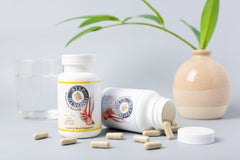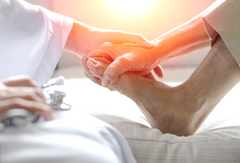Rheumatoid Arthritis & Foot Health

by Dr. Emily Splichal, DPM MS
Rheumatoid arthritis (RA) is a chronic, inflammatory condition in which the immune system attacks the lining that surrounds the joints. It tends to target smaller joints first, such as those in the hands and feet. In fact, more than 90 percent of people with RA will develop pain, stiffness and swelling in the foot and ankle over the course of the disease.
The Rheumatoid Foot
The characteristic symptom of RA is increased inflammation at the joint, specifically the synovial lining. Chronic, persistent inflammation in the joints causes swelling, breakdown of the cartilage and softening of the bone. Overtime, this can result in digit contractions and dislocation or deviation of the toes and joints.

Some of the most common foot conditions associated with of RA include:
- Hammer toes
- Metatarsalgia (ball of foot pain)
- Bunions
- Plantar fasciitis
Deviation and dislocation of the toe joints can put excess pressure on certain parts of the foot, increasing the risk of painful calluses and skin breakdown. Below are a few great options to support and offload the foot.

Proper footwear with sufficient cushioning and offloading arch supports or foot pads can help balance out the pressure in the rheumatoid foot.
Insoles such as those made of plastazote are designed to take the shape of the foot and act like memory foam to improve comfort.
Toe spacers can help support proper digit alignment and minimize the risk of joint dislocation.
Finally, daily massage of the feet and calves can improve circulation and minimize any tissue adhesions or trigger points.
Minimizing Inflammation
Successful management of RA-associated foot pain also requires considering systemic inflammation levels, as it is the chronic inflammation which is leading to joint breakdown.
Systemic inflammation can be controlled through certain RA medications, oral NSAIDs, diet and supplements such as systemic enzymes.

Depending on the level of foot pain, inflammation may also need to be managed locally at the joint. Cortisone injections, topical NSAIDs, and red-light therapy have all been shown to help minimize inflammation and pain.



Leave a comment